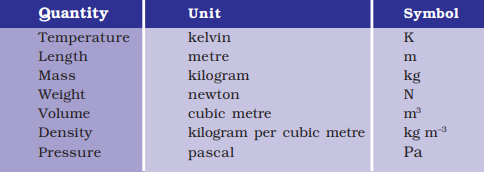MATTER IN OUR SURROUNDINGS for Class 9 CHEMISTRY
INTRODUCTION
Our universe is made up of material which we call Matter and as our surroundings are a part of this universe, then it is right to say that our surroundings are also made of Matter.
For example, the food we eat, the air we breathe in, the clothes we wear, the water, clouds, stars all are matter
So, Matter is defined as anything that occupies space, possesses mass. The Indian philosophers said that matter is made from five constituents, tattvas. These are air, earth, water, fire, and sky.
Matter Around Us
Humara universe jis material se bana hua h usse hum matter bolte h aur humari surroundings universe ka hi part h so iske according hum yahan ye kah sakte h ki surroundings b matter ki bani hui h. For example jo food hum khate h, jis air meh hum saans (breathe) lete h, clothes jo hum daalte h, water, clouds, stars sabhi matter h.
So matter wo substance hota h jo space occupy aur mass possess karta h. Indian philosophers ke according matter 5 tattvas (constituents) se bana hua hota h - air, earth, water, fire aur sky.
Sabse pehle matter ke nature ke regarding 2 different point of views the:
(a) Matter continuous nahi hota.
(b) Matter particulate hota h.
Ab final conclusion ke liye hum yahan ek activity perform karte h: Iske liye hum salt or sugar ko beaker of water meh add karte h. Ab yahan salt or sugar ke particles water meh dissolve ho jate h, jis wajah se hum inko water meh separately nahi dekh sakte. Iska matlab ye hua ki ab particles of salt or sugar, interparticle space in water meh entered karne ki wajah se throughout the water spread ho jate h. Hence, hum kah sakte h ki Matter is particulate i.e., ye particles se bane hue hote h.
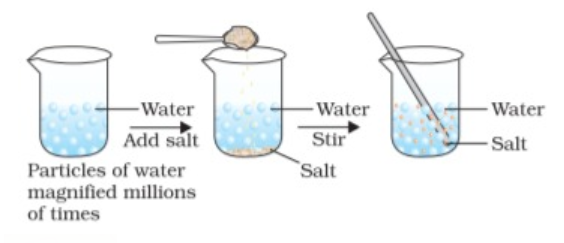
Fig : When we dissolve salt in water, the particles of salt get into the spaces between particles
of water.
Size of Particles : Particles ka size generally very small hota h, but ye matter to matter differ karta h. Ab particles ke small size ko confirm karne ke liye hum ek activity perform karte h.
Iske liye hum Potassium Permanganate ke 2-3 crystals ko 10 mL water in test tube consider karte h, iss solution ka colour purple hota h. Ab iss solution ki 1 mL volume ko hum ek aur test tube meh lete h aur isme 9 mL water add kar, overall volume ko 10 mL karte h. As a result, purple colour ki intensity decrease ho jati h. Ab iss experiment ko 3-4 baar repeat karne par hum ye observe karte h ki dilution ke sath purple colour lighter aur lighter hota h. Ab aisa kyun hota h?
Since previous dark coloured 1 mL solution ke dilution ke sath number of ions per unit volume decrease hoti h, jis wajah se iska colour lighter aur lighter hota h.
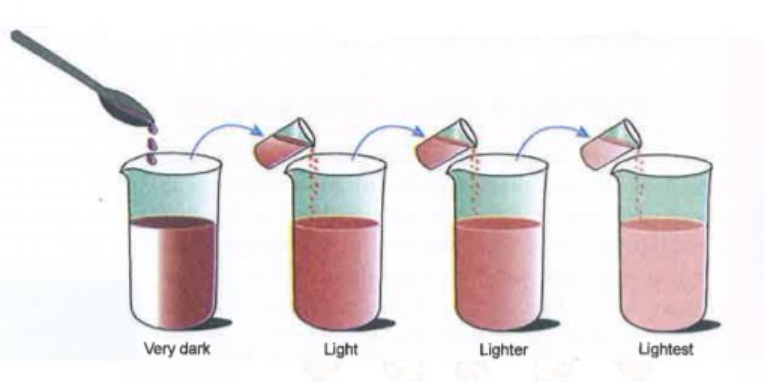
Fig : Estimating how small are the particles of matter with every dilution, though the colour becomes light, it is still visible
Matter Around Us
Earlier there were two different points of views regarding the nature of Matter:
(a) Matter is not Continuous
(b) Matter is Particulate
In order to reach a conclusion we can perform the following activity: Dissolve sugar or salt in a beaker of water, the sugar or salt completely dissolves in it and we are not able to see them separately which means the particles of sugar or salt have entered into the interparticle space in the water and is now spread throughout the water. Hence we can say that Matter is Particulate i.e Made up of particles

Fig: When we dissolve salt in water, the particles of salt get into the spaces between particles of water.
Size of Particles: These are usually very small in size so small that they cannot be viewed with the naked eye, but they can vary from matter to matter.
We have learned above that matter is made up of small particles. To know how small are these particles, let us perform an activity
Take 2 - 3 crystals of potassium permanganate and dissolve them in 10 mL of water taken in a test tube colour of the solution will be purple. Now transfer 1 mL of this solution to another test tube and add 9 mL of water to make the volume again to 10 mL. The intensity of the purple colour will somewhat decrease. Repeat this experiment 3-4 times. Note that the purple colour will not disappear altogether it becomes lighter and lighter slowly with dilution.
This happens because on diluting the 1mL solution from the previous dark-colored solution the number of ions per unit volume decreases and hence the color becomes lighter and lighter.

Fig: Estimating how small are the particles of matter with every dilution, though the colour becomes light, it is still visible
Characteristics of Matter
Ab jaise ki hume padha ki matter particles se banta h, lekin inn particles ke kuch characteristics features hote h, jisko hum yahan discuss karenge:
1. Particles of Matter Have Space Between Them - Ab jaise humne above activities meh padha ki jab sugar or Potassium Permanganate, water meh dissolved hote h tab ye water meh evenly distributed hote h. Kyunki tab ek type ke matter particles dusre type ke matter particles ke free space meh enter karte h. Jo ye show karta h ki particles of matter ke beech enough space hota h jisse hum Interparticle Spaces or Voids bolte h.

Fig : When we dissolve salt in water, the particles of salt get into the spaces between particles
2. Particles of Matter are Continuously Moving - Ab jaise ki hume pata h ki matter ke particles tiny hote h aur ye Voids se separated hote h. Lekin kya ye particles move karte h ya stationary rahte h? So jaise humne apni daily life meh observe kiya h ki jab hum perfume or air freshener ko spray karte h, tab uske particles ek particular place par nahi rahte rather ye whole room meh spread up ho jate h iske according hum ye conclude kar sakte h ki particles Moving or in Motion hote h. Ab iss motion of particles ko hum diffusion bolte h.
Since particles continuously move karte h, jiska matlab ye Kinetic Energy possess karte h. Ab jaise hum apne ghar ke kitchen meh food prepare karte h, tab uss food ki smell dusre rooms tak b aati h, so ye diffusion phenomenon ki wajah se hota h. Lekin jab hum yahan temperature increase karte h, tab ye particles faster move karte h. As a result, hum yahan kah sakte h ki temperature increase karne se inn particles ki kinetic energy increase hoti h, then particles of matter intermix on their own with each other. They do so by getting into the spaces between the particles. Ab two different types of matter ke particles ki aapas meh intermixing ko hum diffusion bolte h. Moreover, hum ye b observe karte h ki heating ke sath diffusion process faster hota h kyunki tab particles ki kinetic energy increase hoti h.
Note: Kinetic energy is the energy possessed by a body by virtue of its motion.
Critical Thinking
(a) Diffusion - (i) In Gases : Ab diffusion process ko hum 2 gases ki mixing se study karenge.
Iske liye hum 2 glass jars lete h - ab ek glass jar meh red brown vapours of bromine present h aur dusre meh air present h, jisko hum bromine vapour glass jar ke oopar rakhte h. Initially red brown vapours of bromine lower glass jar se above glass jar jisme air present h usme spread up ho jati h. Later on, jis glass jar meh air present h wo completely red brown colour ka ho jata h.
Since air aur bromine vapours tiny moving particles hote h, jis wajah se jab ye particles aapas meh collide karte h tab ye har directions meh bounce kar diffusion ki wajah se easily mixed ho jate h. Ab air particles b downward aate h lekin ye colourless hote h jis wajah se hum inki movement nahi dekh paate h.
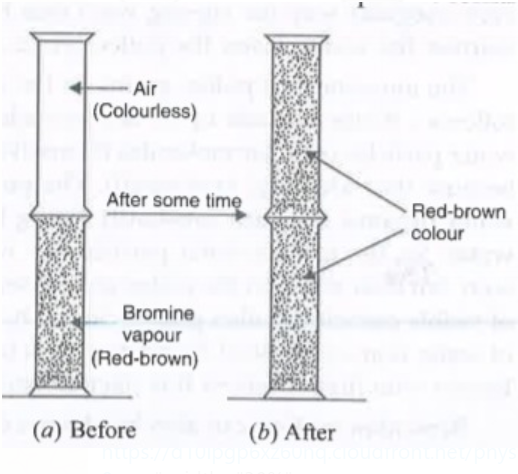
Fig : Diffusion of Bromine vapour into air
(ii) In Liquids : Ab diffusion in liquids in comparison to diffusion in gases slower hota h, kyunki liquids meh particles in comparison to gases slowly move karte h. Lekin liquids meh relative diffusion rate different hota h jis wajah se paint colours, water meh easily spread ho jate h whereas honey, water meh dissolved hone ke liye time leta h.

Fig : Liquids differ in rate of diffusion.
Here are some examples of Diffusion of Solids in Liquids :
The diffusion of copper sulphate in water : Ab jab hum blue Copper Sulphate ke crystals ko beaker of water meh add karte h, tab beaker ka water slowly blue colour meh convert hone lagta h. Crystals of Copper Sulphate little amount of water meh dissolved hone ke sath solution meh copper sulphate ke particles form karte h. Ab kuch time ke baad particles of water aur copper sulphate solution dono hi motion meh hote h, jis wajah se blue solution upwards aur colourless water solution downwards move karta and hence diffusion ki wajah se ye mixed ho jate h.
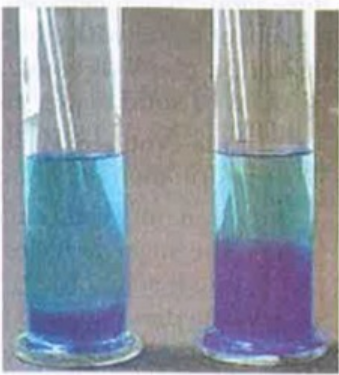
Fig : Diffusion of copper sulphate in water
The diffusion of potassium permanganate in water : Similarly, jab hum crystal of potassium permanganate ko beaker of water meh add karte h, tab beaker ka water slowly purple colour meh convert hone lagta h. Ab water meh spreading of purple colour of potassium permanganate on its own diffusion process ki wajah se hota h.
(iii) In Solids : Ab diffusion in solids very slow process hota h, kyunki solids meh particles tightly packed hote h aur inme little inter-particle space hota h. For examples
Monsoon season meh wooden doors, chairs, tables etc., water ko absorb karne ki wajah se swell ho jate h. Ab wooden furniture ki ye swelling diffusion process ki wajah se hoti h.
Moreover, agar hum blackboard par kuch likhne ke baad usse unclean for a period of time chhod de, tab uss blackboard ko clean karna quite difficult ho jata h. Kyunki tab chalk particles, surface of blackboard par diffused ho jate h.
So diffusion process hume regarding nature of matter 2 conclusions deta h:
(i) Matter tiny particles se banta h.
(ii) Particles of matter constantly move karte rahte h.
Brownian Movement : Ab particles of liquid move karte h iska evidence Brownian movement deta h.
Robert Brown conducted an experiment : Ab scientist Robert Brown ne kuch pollen grains ko water meh add kiya aur tab ye observe kiya ki ye pollen grains rapidly zig-zag motion meh move karte h.
Since water tiny particles se bana hua hota h. Ab pollen grains constantly fast moving particles of water ke sath hit hone ki wajah se surface of water par move karte rahte h.
Though water particles ka size chota hota h jis wajah se inko hum nahi dekh sakte, lekin inka pollen grains par effect clearly dekha ja sakta h. Ab small invisible particles of water ki wajah se jo visible particles (pollen grains) ka random motion hota h, wo Brownian motion ka example hota h. Hence the zig-zag motion of a particles is defined as Brownian motion.
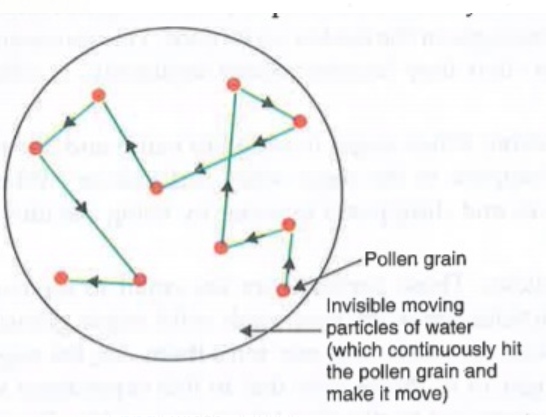
Fig : Brownian motion observed through a microscope in pollen grain
3. Particles of Matter Attract Each Other - Ab particles of a substance ke beech forces hoti h, jo inn particles ko closer rakhti h. Lekin strength of force object to object vary karti h. Isko samajhne ke liye hum example consider karte h - iske liye hum iron nail, a piece of chalk aur ek rubber band lete h. Ab inn teeno ko one by one hammering, cutting or stretching se break karne ki koshish karte h. Yahan hum ye observe karte ki piece of chalk ko easiest aur iron nail ko toughest break kiya jata h. Thus, hum ye conclude kar sakte h ki interparticles forces Iron nail meh strongest aur chalk meh weakest hoti h.
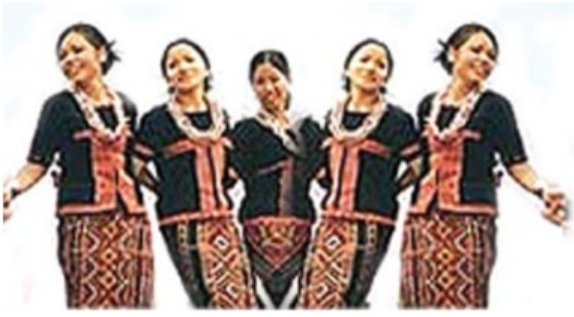
Fig : Showing how particles hold each other
Above image ki tarah particles of matter b ek dusre ko hold karte h aur jitna stronger ye hold karte h utni stronger inn particles ki interparticle forces hoti h aur utni lesser inn particles ki mobility hoti h.
Common Unit & S.I. Unit of Temperature
Ab temperature ko hum three scales meh measured kar sakte h - jisko hum celsius scale (∘C), Fahrenheit scale (F) aur Kelvin scale (K).
Jo thermometers Celsius scale meh hote h wo 0∘C to 100∘C meh calibrated hote h.
Jo thermometers Fahrenheit scale meh hote h wo 32∘F to 212∘F meh calibrated hote h.
Also, temperature ki S.I. Unit Kelvin hoti h, jisko hum commonly calculations meh use karte h.
Ab different scales ko hum ek dusre se relate kaise karte h:
∘F=(95)∘C+32∘
K=∘C+273
Kelvin temperature ko hum capital letter (K) se represent karte h, na ki small letter (k) se.
Ab Celsius scale temperature ko Kelvin scale meh convert karne ke liye hum Celsius temperature meh 273 add karte h.
Similarly Kelvin scale temperature ko Celsius scale meh convert karne ke liye hum Kelvin temperature meh 273 subtract karte h.
For example The room temperature on the Celsius scale is 25∘C. Convert it into the other two scales of measurement.
Solution : Temperature on kelvin scale = 25 + 273 = 298K
Temperature on Fahrenheit scale = 95×25+32∘ = 77∘F
The body Temperature of a normal and healthy person is 98.4∘F
Characteristics of Matter
It is known that matter is made up of particles but these particles have some characteristic features which are as following:
1. Particles of Matter Have Space Between Them - By the above activity, we have seen that when sugar or Potassium Permanganate dissolves in the water they get evenly distributed because particles of one type of matter get into the spaces between particles of the other. This shows that there is enough space between particles of matter called Interparticle Spaces or Voids.

Fig: When we dissolve salt in water, the particles of salt get into the spaces between particles
2. Particles of Matter are Continuously Moving - As we know that the particles of matter are tiny and are separated by Voids, now we must wonder that whether these particles are moving or stationary. We have observed in our daily life that when we spray perfume or air freshener it does not stay at a particular place rather it spreads around and takes up the whole room by this we can conclude that particles are Moving or in Motion. This motion of particles is called Diffusion.
Particles of matter are continuously moving that is they possess Kinetic Energy. We have observed that when food is cooked in the kitchen we can feel its smell in the rooms at a distance from the kitchen, this is because of the Phenomenon of Diffusion. What happens is, as the temperature rises, particles move faster so, we can say that with the increase in temperature the kinetic energy of the particles also increases the particles of matter intermix on their own with each other. They do so by getting into the spaces between the particles. This intermixing of particles of two different types of matter on their own is called diffusion. We also observe that on heating, diffusion becomes faster because on heating the Kinetic Energy of the particles becomes faster.
Note: Kinetic Energy is the energy possessed by a body by virtue of its Motion.
Critical Thinking
(a) Diffusion - (i) In Gases: The mixing of two gases can be explained on the basis of diffusion
A gas jar containing air is placed upside down on a gas jar of bromine vapour. We see that the red-brown vapours of bromine from the lower gas jar spread up into the air in the upper gas jar, and after some time the gas jar containing air also becomes completely red-brown in colour.
This is because the air and bromine vapour are made of tiny moving particles these moving particles collide with each other and bounce about in all directions and get mixed easily due to diffusion. The air also comes downwards but we cannot see its movement because it is colourless.

Fig: Diffusion of Bromine vapour into air
(ii) In Liquids: Diffusion in liquids is slower than that in gases. This is because the particles in liquids move slowly as compared to the particles in gases, but the relative diffusion rate between liquids is different this is the reason why paint colours spread easily in water whereas it takes time for honey to get dissolved.

Fig: Liquids differ in rate of diffusion
Here are some examples of diffusion of Solids in Liquids:
The diffusion of copper sulphate in water: When a few crystals of blue Copper Sulphate are placed at the bottom of a beaker containing water, then water in the whole beaker turns blue slowly. The crystals of copper sulphate dissolved in a little water around them to form fine particles of copper sulphate in solution. Then after some time the particles of water as well as copper sulphate solution are in motion due to which the blue solution moves upwards and colourless water solution moves downwards and hence get mixed due to diffusion.

Fig: Diffusion of copper sulphate in water
If a crystal of potassium permanganate is placed at the bottom of the water in a beaker, then the purple colour of potassium permanganate spread into the whole water, slowly. The spreading of the purple colour of potassium permanganate into the water, on its own, is due to the diffusion of potassium permanganate particles into
water.
(iii) In Solids: Diffusion in solids is a very slow process because the particles are tightly packed, and there is little inter-particle space. Here are some examples :
During monsoon season we observe that the wooden doors, chairs, tables etc., swell up a little because the wooden furniture absorbs water by diffusion.
We write something on a blackboard and leave it uncleaned for a considerable period of time (say, at least 10 to 15 days), we will find that it becomes quite difficult to clean the blackboard afterwards. This is due to the fact that some of the particles of chalk have diffused into the surface of the blackboard.
The process of diffusion gives us two conclusions about the nature of matter:
(i) That matter is made up of tiny particles.
(ii) That the particles of matter are constantly moving.
Brownian Movement - It can also be used as evidence to prove that particles of a liquid are in motion.
Robert Brown conducted an experiment: He suspended some pollen grains in water and observed that they were moving rapidly in a zig-zag motion.
The reason was that water is made up of tiny water particles. The pollen grains move on the surface of the water because they are constantly being hit by the fast water moving particles.
Though the water particles are too small to be seen, their effect on the pollen grains can be seen clearly. The random motion of visible particles (pollen grains) caused by the much smaller invisible particles of water is an example of Brownian motion hence the zig-zag motion of a particle is defined as Brownian Motion.

Fig: Brownian motion observed through a microscope in pollen grain
3. Particles of Matter Attract Each Other - The particles of a substance have a force between them that keeps them closer but the strength of this force may vary from object to object. To illustrate this property let’s take an example - Take an iron nail, a piece of chalk, and a rubber band. Try breaking them by hammering, cutting, or stretching, we observe that the chalk is easiest to break and the iron nail toughest. Thus, we can conclude that the interparticle forces are strongest in Iron Nail and weakest in Chalk.
The interparticle forces can be depicted as following:

Fig: Showing how particles hold each other
Just like in this image the girls are holding one another similarly the particles of matter also hold each other and stronger the hold stronger is the inter-particle force and lesser is the mobility of particles.
Common Uunit & SI Uunit of Temperature
There are three scales on which temperature can be measured. These are known as Celsius scale (∘C), Fahrenheit scale (F) and Kelvin scale (K)
Thermometers with Celsius scale are calibrated from 0∘C to 100∘C
Thermometers with Fahrenheit scale are calibrated from 32∘F to 212∘F
Kelvin’s scale of temperature is the S.I. scale and is very common in calculations.
The different scales are related to each other as:
∘F=(95)∘C+32∘
K=∘C+273
Kelvin’s temperature is represented by a capital letter (K) and not by a small letter (k).
To convert temperature on the Celsius scale to Kelvin scale, add 273 to the Celsius temperature.
To convert temperature on the Kelvin scale to Celsius scale, subtract 273 from the Kelvin temperature.
For Example, The room temperature on the Celsius scale is 25∘C. Convert it into the other two scales of measurement.
Solution: Temperature on Kelvin scale = 25 + 273 = 298K
Temperature on Fahrenheit scale = 95×25+32∘ = 77∘F
The body Temperature of a normal and healthy person is 98.4∘F.
EXAMPLE 1
The boiling point of ethyl alcohol is 78∘C. What is the corresponding temperature on Kelvin scale ?
Temperature on Kelvin scale = 78 + 273 = 351 K.
EXAMPLE 2
What temperature in Kelvin scale is equal to 50∘C ?
Temperature on Kelvin scale = 50+273 = 323 K
EXAMPLE 3
Can we regard high fever as matter ?
High fever is feeling only, it can't be regarded as matter.
Different States of Matter
Ab hamare aas paas matter 3 forms meh exist karta h. These are Solid, Liquid, Gas
Hum apni body ko inn 3 states meh classify kar sakte h:
(1) Solids - Teeth, Nails, Bones
(2) Hamare lungs meh jo air present hoti h wo Gas h.
(3) Iske alawa hamari body 70 % water se bani h, jo Liquid h.
Ab ye teeno states of matter, difference in interparticles spaces ki wajah se h. Ab hum inn states of matter ki properties ko detail meh study karenge:
The Solid State : Solids meh interparticles space least hota h.
(i) Solids ki definite shape, distinct boundaries aur fixed volumes hoti h.
(ii) Solids ki negligible Kinetic energy hoti h. Since solids meh particles closely packed hote h, matlab ye freely move nahi karte h iss wajah se solids flow nahi karte h.
(iii) Jab solids par outside force lagayi jaati h, tab inke paas apni shape retain karne ki tendency hoti h. Ab kuch solids apni shape change b karte h, lekin jab hum force ko remove karte h tab ye apni original configuration ko regain kar lete h (e.g. sponge) aur iske alawa jab hum large amount of force apply karte h tab ye break kar jaate h and hence called Rigid (A piece of chalk).
Few examples: Ab rubber band par jab hum force apply karte h tab ye apni shape change karta h aur jaise hi hum force remove karte h tab ye apni same shape regain karta h. Moreover, jab hum yahan excessive force apply karte h, tab ye break karta h.
Jaise each individual sugar or salt ki shape in our hand, in plate or in a jar fixed rahti h.

Fig : Interparticle space in a solid .
(iv) Solids ko hardly compressed kiya ja sakta h by applying pressure. For example ek smaller piece of stone ke pressure se larger piece of stone ko compress nahi kiya ja sakta. Lekin kuch solids compressed ho sakte h jaise sponge.
The Liquid State:
(i) Liquids ki fixed shape nahi hoti lekin inki fixed volume hoti h. Ab kisi liquid ko hum jis container meh daalte h, wo liquid uss container ki shape le leta h.
(ii) Liquids flow karne ke sath apni shape b change kar sakte h, jis wajah se inko hum rigid na bolkar Fluid bolte h.
(iii) Liquids ki density, solids se lower hoti h, kyunki liquids meh interparticles spaces with respect to solids large hota h aur issi wajah se liquids ki solid ki respect meh higher Kinetic energy hoti h. Ab jaise hume pata h water meh dissolved oxygen hoti h jo aquatic organisms ke survival ke liye important hoti h, hence hum kah sakte h ki gases particles liquids meh diffuse ho sakte h. Ab liquid particles ka diffusion rate in comparison to that of solids higher hota h, kyunki liquids meh particles freely move karte h aur inke beech greater space hota h as compared to particles in the solid state.
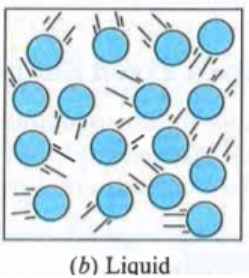
The Gaseous State
(i) Ek gas wo form of matter hoti h jo fluidity possess karti h, lekin ye highly compressible hoti h. Hence gas ki na toh koi definite shape hoti h aur na hi koi definite volume.
(ii) Ab gases ki fluidity least interparticle space aur weak intermolecular forces ki wajah se hoti h aur issi wajah se ye nature meh highly compressible hoti h. Ab iss property ki wajah se hum gas ki large volume ko small cylinder meh compressed kar easily transport b kar sakte h.
(iii) Gases ki least density hoti h.
 .
.
For example hum apne ghar meh Liquified Petroleum Gas (LPG) cooking ke liye use karte h. Oxygen cylinders ko hum hospitals meh used karte h. Compressed Natural Gas (CNG) ko hum vehicles meh use karte h.
Ab agar hume teeno states of matter ki compressibility ko compare karna ho toh tab hum following activity perform karte h.

Iske liye hum three 100 mL syringes lete h aur inki nozzles ko rubber corks se close kar dete h. Ab sabhi syringes se pistons ko remove karte h.
Further first syringe ko as such chhod dete h, second syringe ko water se fill karte h aur third syringe ko pieces of chalk se. Ab inn syringes par pistons ko dubara laga dete h. Later on inn syringes meh jo content h usko hum piston se push kar compress karte h. Then we observe:
1) First syringe ki piston jisme air (gas) present h wo considerably pressure meh move karti h. Iska matlab pressure apply karne par air smaller volume meh compressed ho jati h. In other words, gases highly compressible hoti h.
2) Similarly second syringe ki piston jisme water (liquid) present h wo slight pressure meh move karti h. Iska matlab liquids slightly compressible hote h.
3) Ab third syringe ki piston jisme chalk pieces (solid) present h wo move nahi karte. Iska matlab solids completely incompressible hote h.
So Gases ki highest Kinetic energy hoti h, kyunki inke beech interparticles space maximum hota h as a result inke particles widely separated hote h aur iske alawa volume of a given mass of gas is large and density is low.

Fig : a, b and c show the magnified schematic pictures of the three states of matter. The motion of the particles can be seen and compared in the three states of matter
Critical Thinking
Osmosis - Ab osmosis ek type ka diffusion hota h, jisme passage of water or solvent molecules from a region of high water or solvent concentration to a region of low water or solvent concentration through a semipermeable membrane (jo membrane sirf certain ions or molecules ko paas karti h) hota h.

Fig : Difference between Osmosis and Diffusion
Osmosis process se hum fruits aur meats ko preserve kar sakte h, though dono ke liye pura process different hota h.
Ab fruits ke case meh osmosis process, fruits ko dehydrate karta h whereas preservation of meat meh osmosis draws salt into it, jis wajah se bacteria isme enter nahi karta h.
Hello Points !!!
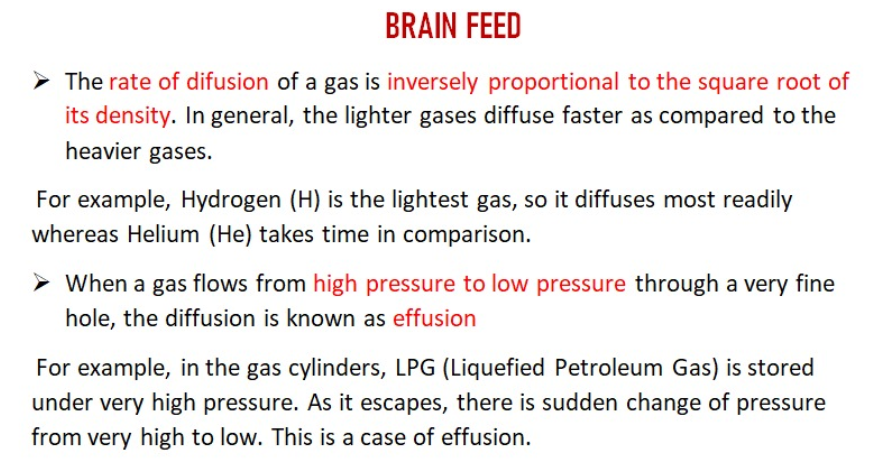
Different States of Matter
Matter around us exists in three forms. These areSolid, Liquid, Gas.
We can classify our body in these 3 states -
Teeth, Nails, Bones are Solids.
Air present in our lungs is Gas.
Our body is made up of 70% water which is Liquid.
These three states of matter are because of the difference in interparticle spaces. Now, let us study the properties of these three states of matter in detail.
The Solid State : In solids the interparticle spaces are least in number.
1) They have a definite shape, distinct boundaries, and fixed volumes.
2) They have negligible Kinetic energy as the particles are closely packed and are not free to move, hence solids do not flow.
3) Solids have a tendency to maintain their shape when subjected to an outside force, Some solids may change their shape but regain the original configuration when force is removed (e.g Sponge) and they may break when a large amount of force is applied hence called Rigid (A piece of Chalk).
Few examples: A rubber band changes shape under force and regains the same shape when the force is removed. If excessive force is applied, it breaks.
The shape of each individual sugar or salt crystal remains fixed, whether we take it in our hand, put it in a plate, or in a jar.

Fig: Interparticle space in a solid.
4) Solids can hardly be compressed on applying pressure. For example, we cannot press a large piece of stone by applied pressure with a small piece of stone but some of the solids can be compressed like a sponge.
The Liquid State:
1) Liquids have no fixed shape but have a fixed volume. They take up the shape of the container in which they are kept.
2) Liquids can flow and change shape, so they are not rigid but can be called Fluid.
3) Their density is lower than that of solids due to large inter-particle spaces than solids and due to the same reason liquids have higher Kinetic Energy than solids. We know that water has oxygen dissolved in it which is important for the survival of aquatic organisms, hence it is safe to say that gases can diffuse into liquids. The rate of diffusion of liquid particles is higher than that of solids. This is due to the fact that in the liquid state, particles move freely and have greater space between each other as compared to particles in the solid-state.

The Gaseous State
1) A gas is defined as that form of matter which possesses fluidity but is highly compressible and hence has neither definite shape nor definite volume.
2) The fluidity of gases is due to least interparticle space and weak intermolecular forces and the same reason corresponds to their highly compressible nature, due to this property a large volume of gas can be compressed into a small cylinder and can be transported easily.
3) Gases have the least density.
 .
.
For e.g The Liquefied Petroleum Gas (LPG) we use at our homes for cooking, Oxygen cylinders used in hospitals, Compressed Natural Gas (CNG) used for vehicles. If we were to compare the compressibility of all three states of matter we can do that with the help of the following activity:

Take three 100mL syringes and close their nozzles with rubber corks. Remove the pistons from all the syringes.
Leave the first syringe as such, fill the second syringe with water and the third syringe with pieces of chalk. Now insert the pistons back into the syringes. Try to compress the contents by pushing the piston in each syringe.
We observe:
1) The piston of the first syringe which contains air moved under considerable pressure. This means that on applying pressure, air (gas) gets compressed to a smaller volume. In other words, gases are highly compressible.
2) The piston of the second syringe which contains water (a liquid) move in only slight pressure. This means that liquids are only slightly compressible.
3) The piston of the third syringe which contains chalk pieces (a solid) did not move. This means that solids are completely incompressible.
Gases have the highest kinetic energy due to maximum interparticle space as a result of which the particles of gas are widely separated and volume of a given mass of gas is large and density is low.

Fig: a, b and c show the magnified schematic pictures of the three states of matter. The motion of the particles can be seen and compared in the three states of matter
Critical Thinking :
Osmosis - Osmosis is a type of diffusion in which there is passage of water or solvent molecules from a region of high water or solvent concentration through a semipermeable membrane (A membrane which allows only certain ions or molecules to pass through it) to a region of low water or solvent concentration.

Fig : Difference between Osmosis and Diffusion
Osmosis is also used for preserving fruits and meats, though the process is quite different for the two.
In the case of fruit, osmosis is used to dehydrate it, whereas in the preservation of meat, osmosis draws salt into it, thus preventing the intrusion of bacteria.
Hello Points !!!

Hello Points !!!
To sum up the differences between the Three States of Matter.
Table : Comparison of characteristic

EXAMPLE 4
Why do not solids possess fluidity ?
Fluidity means tendency to flow. The constituents in the solids are very closely packed and inter-particle forces are quite strong. Therefore, solids have hardly any fluidity.
EXAMPLE 5
Why are gases highly compressible while solids are almost incompressible ?
In the gases, the inter particle or intermolecular spaces are very large. These can be decreased to a large extent on applying pressure. Therefore, the gases are highly compressible. However, in solids these spaces are very small and cannot be decreased any more on applying pressure. Therefore, the solids are almost incompressible.
EXAMPLE 6
List any two properties of liquids which are common to gases.
(i) Both of them do not have any definite shape. They can take up the shape of the container in which these are kept.
(ii) Both of them show the property of diffusion. However, gases diffuse faster.
Change of States of Matter
Ab jaise ki hume pata h water three states of matter meh exist karta h:
• Solid, as Ice
• Liquid, as the familiar Water
• Gas, as Water Vapour.
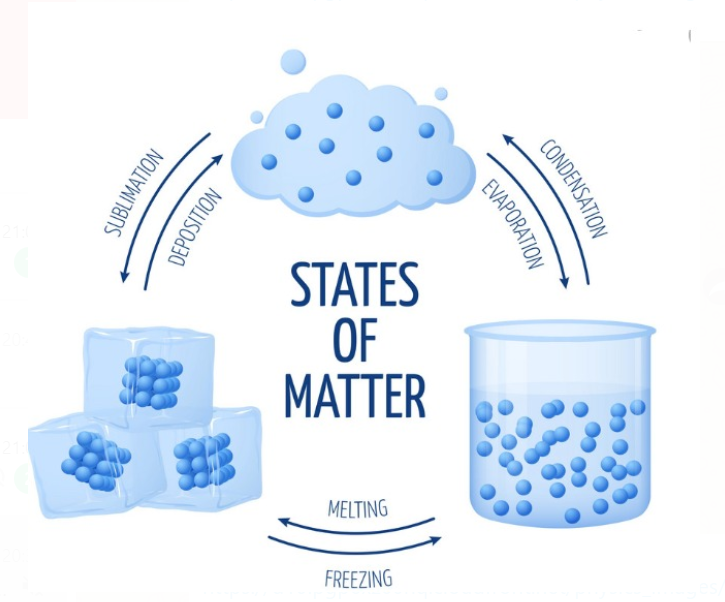
Since teeno states of matter meh difference, constituent particles ke beech space ke difference ki wajah se hota h. Ab ye space solid state meh minimum, liquid state meh intermediate aur gaseous state meh maximum hota h.
Iska matlab jab koi solid, liquid meh convert hota h tab inke particles ke beech space increase hota h. Similarly jab koi liquid, gas meh convert hota h tab inke particles ke beech space further increase hota h.
Since, Interparticle distance aur Interparticle forces of attraction ek dusre ke inversely proportional hote h. Thus, Interparticle distances aur Interparticle forces of attraction ko change karne ki wajah se ek state of matter dusre state of matter meh convert ho jata h.
Ab Interconversion of matter following two ways meh achieve ho sakta h:
1.) By changing the Temperature
2.) By changing the Pressure
Effect of Temperature:
(a) Solid To Liquid - MELTING
Jab hum some amount of ice ko beaker meh laboratory thermometer ke sath melting ke liye burner par rakhte h, as a result tab ice melt hone ki wajah se temperature fluctuate hone lagta h. Ab jis temperature par ice completely melt hokar liquid meh convert ho jati h uss temperature ko hum ice ka Melting Point bolte h.
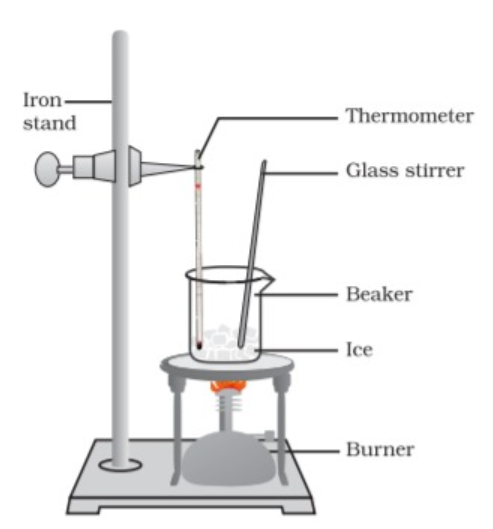
Thus, jis temperature par solid atmospheric pressure par melt hokar completely liquid meh convert hota h usse hum uska Melting Point bolte h. Also, process of melting matlab change of solid into liquid state ko hum Fusion bolte h.
Note - The melting point of ice is 273.16 K.
Since solids ka temperature increase karne ki wajah se inke particles ki Kinetic energy increase hoti h, jis wajah se yahan particles greater speed meh vibrate karte h. Ab heat ki form meh hum jo energy provide karte h wo particles ki beech ki forces of attraction ko overcome karta h aur tab particles apni fixed positions ko chhod, freely move karte h. Later ek aisa stage aata h jab solid melt hokar liquid meh convert hota h, lekin jab solid melt hota h tab iska temperature constant rahta h. Ye yahan heat energy ki wajah se hota h jisko hum solid particles ke beech forces of attraction ko overcome karne ke liye use karte h, during solid to liquid interconversion without increasing their kinetic energy. Iss heat ko hum Latent Heat of Fusion bolte h (Latent means hidden aur Fusion means Melting).
Note: Latent heat of fusion wo amount of heat energy hoti h jo 1 kg solid ko liquid meh convert karti h at atmospheric pressure aur at its melting point.
For example Latent heat of fusion of ice 334 kJ/kg hoti h, jiska matlab ice ko 334 kJ of heat required hoti h in order to convert 1 kg of ice into liquid at its melting point which is 273 K or 0∘C.
Note: Jab ice, water meh convert hoti h tab ye latent heat absorb karti h, lekin jab water freeze hokar ice banata h, tab ye equal amount of heat ko release karta h.
Significance of Melting Point Temperature
Melting point of a solid hume uss solid ki interparticles forces ka idea deta h jo solid ke constituents ko bind karta h. Thus, jitna jyada kisi solid ka melting point hota h, utni jyada uss solid ki intermolecular forces ki magnitude hoti h. For example NaCl ka melting point 1077 K aur Magnesium chloride ka melting point 1260 K hota h. Iska matlab solid magnesium chloride ke ions meh attractive forces strong h in comparison to ions in sodium chloride.
(b) Liquid To Solid - FREEZING
Jaise humne above case meh discuss kiya ki jab hum solid ka temperature increase karte h, tab ye liquid meh melt ho jata h. Conversely, jab hum yahan temperature ko lower karenge tab iska reverse process hota h. As a result, tab particles ki kinetic energy decrease hoti h aur particles slowly move karte h. Ab jaise temperature further lowered hota h tab attractive forces particles ko ek dusre ki taraf pull karte h aur tab substance freeze ho jata h i.e., liquid changes into solid. Thus,
Jis temperature par liquid freeze hokar solid ban jata h at atmospheric pressure usko hum Freezing point bolte h. Also, process of freezing i.e., change of state from liquid to solid ko hum Solidification bolte h.
(c) Liquid To Gas - BOILING
Ab melting of ice ke previous experiment meh jab hum beaker ko some more time ke liye burner par rakhte h, tab liquid starts converting to vapour.
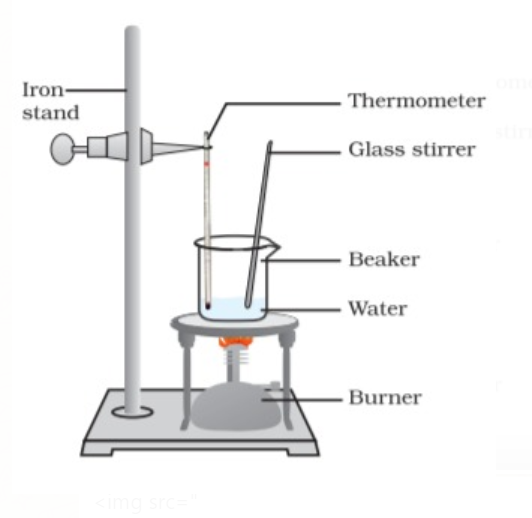
Ab jab hum water ko heat energy provide karte h, tab particles even faster move karte h. Ab ek certain temperature par particles ke paas enough energy hoti h, jo inke beech ki forces of attraction ko break kar deti h. Iss temperature par liquid starts changing into gas. Thus, jis temperature par liquid boil karna start karta h at atmospheric pressure usko hum Boiling point bolte h. Ab boiling ek bulk phenomenon h, jisme particles bulk of the liquid se enough energy gain kar vapour state meh change hote h. Water ka boiling point 373 K hota h. Similarly iss case meh b temperature change nahi hota just the state changes kyunki yahan hum heat ko vapour form state meh change karne ke liye use karte h aur iss heat ko hum Latent Heat of Vaporisation bolte h.
Latent heat of vaporisation of water 2260 kJ/kg hoti h, iska matlab jab hum 1 kg water ko steam meh convert karte h tab ye 2260 kJ heat absorbed karta h.
Note: Jab water, steam meh change hota h tab ye latent heat absorb karta h, lekin jab steam condense hokar water form karta h tab ye equal amount of latent heat release karta h.
Since steam meh jyada heat hoti h in the form of latent heat than boiling water, iss wajah se ye observed kiya jata h ki steam se jo jalan (burns) hoti h wo in comparison to boiling water bahut jyada hoti h though dono hi same temperature par hote h at 100∘C.
Significance of Boiling Point Temperature
Ab melting point ki tarah, liquids ka boiling point temperature magnitude or strength of the interparticle or intermolecular substance forces present in them ko compare karne meh help karta h.
So jitni jyada forces hoti h, utna jyada uss liquid ka boiling point hota h. In general, low boiling liquids jaise petrol, ether, acetone, alcohol etc., ke paas weaker intermolecular forces hoti h as compared to high boiling liquids jaise water, carbon tetrachloride etc., Moreover, low boiling liquids ko hum volatile liquids bolte h.

(d) Solid To Gas - SUBLIMATION
Iske liye hum camphor or ammonium chloride ko china dish meh crush karte h aur iske oopar inverted funnel rakhte h aur isse cotton plug se close kar dete h. Then isse hum heat karte h, after heating ammonium chloride ke vapours arise hote h, jo upper portion of funnel ke cool hone ki wajah se wahan solidified ho jate h.
Ab solid state ka direct gas state meh conversion without changing into liquid state or gas state ka direct solid state meh conversion ko hum Sublimation bolte h.
Ab jo solid substance sublimation meh jaata h usse hum Sublime bolte h aur jo products cooling of solid vapours ke baad milte h usse hum Sublimate bolte h.
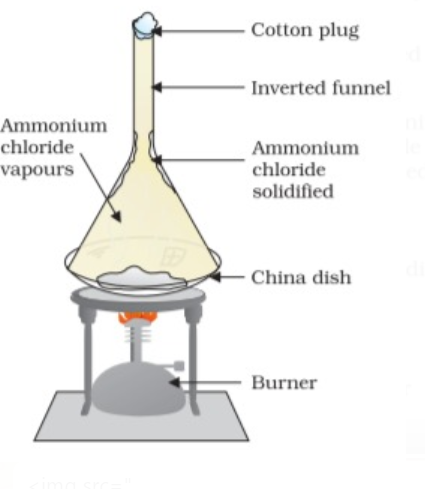
Fig : Sublimation of ammonium chloride
Similarly, Naphthalene balls ko hum apne ghar meh used karte h in order to protect clothes from insects.
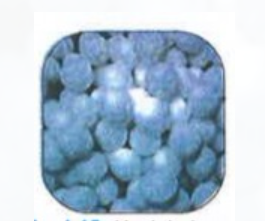
Fig : Naphthalene balls
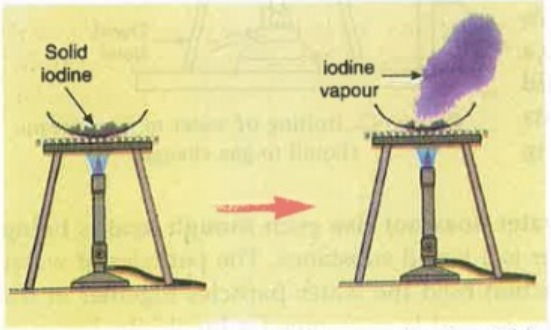
Fig : Sublimation of iodine
(e) Gas To Liquid - CONDENSATION
Jab hum covered container meh glass of water ko boil or tea prepare karte h, tab lid of the container ko remove karne par hum observe karte h ki small water droplets of water backside of the container present hoti h. Kyunki tab steam, water droplets meh convert ho jati h, matlab tab gas state, liquid state meh change ho jati h jisse hum Condensation bolte h.
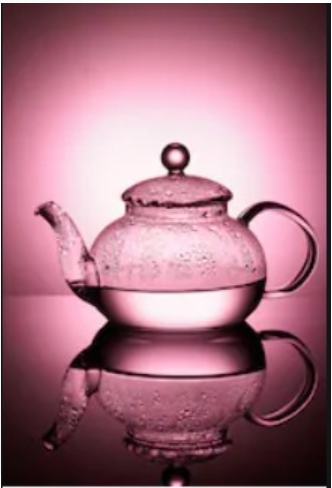
Effect of Change of Pressure
Ab pressure increase karne se b substance ke particles closer aate h. As a result, inka interparticle space decrease or intermolecular forces increase ho jati h. Jis wajah se further inki physical state b change ho jati h. For example hum yahan ek certain volume of gas ko piston ke sath cylinder meh lete h. Ab hum iss gas ko piston se push kar compress karte h, as a result gas small volume meh compress ho jati h. Consequently, tab interparticle distance decrease hota h aur particle ek dusre ke sath itne close aa jate h ki ye ek dusre ko attract kar liquid banate h. In other words, pressure apply karne par gas is liquified.
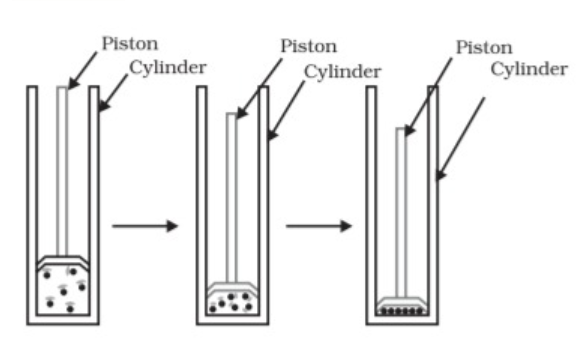
Fig : By applying pressure, particles of matter can be brought close together
Ab hume ye pata h ki gases under high pressure liquified hoti h, lekin isko hum temperature decrease karne se b achieve kar sakte h. Kyunki temperature decrease hone ke sath molecules ki kinetic energy b decrease hoti h, jis wajah se they will come closer and hence get liquified.

Fig : Liquefaction of gas by applying pressure and decreasing temperature
Gases like ammonia, sulphur dioxide, carbon dioxide etc., ko hum easily liquified kar sakte h by either applying pressure at room temperature or by cooling at atmospheric pressure. Ab agar hum carbon dioxide ko under pressure cooled karte h, tab ye directly solid carbon dioxide meh convert ho jati h, jisse hum dry ice bolte h.
Dry ice ko hum under high pressure store karte h, lekin jab dry ice ka pressure 1 atmosphere tak decrease hota h tab ye sublime kar jata h matlab tab ye directly gaseous state meh convert ho jata h (Carbon dioxide gas) without passing through liquid state. Unlike ordinary ice, dry ice jis surface par hoti h usko wet nahi karti, iss wajah se solid carbon dioxide ko hum dry ice bolte h. Also, refrigerant meh ye under the name of Dricold hoti h.

Fig : Dry Ice
Thus, hum yahan kah sakte h ki pressure aur temperature se hum kisi substance ki state ko determine kar sakte h whether it will be solid, liquid or gas.

Fig: Interconversion of the three states of matter
Difference between Gas and Vapours
Vapour term ko hum uss gaseous state of substance ko represent karne ke liye use karte h jo room temperature par liquid hota h aur rest term ke liye hum gas use karte h.
For example since alcohol or mercury room temperature par liquid hote h, jis wajah se hum inke liye alcohol vapours or mercury vapours use kar sakte h. Lekin oxygen room temperature par liquid nahi h iss wajah se isko oxygen vapour se refer nahi kar sakte.

Change of States of Matter
We all know from our observation that water can exist in three states of matter–
• Solid, as Ice.
• Liquid, as the familiar Water.
• Gas, as Water Vapour.

We know that the difference in the three states of matter is due to the difference in the space (or distances) in between the constituent particles. These spaces are minimum in the solid-state, intermediate in the liquid state, and maximum in the gaseous state.
This means that if a solid is to be converted into liquid, the spaces in between the particles have to be increased. Similarly, if a liquid to be converted into a gas, the spaces in between the particles have to be further increased.
The Interparticle distances are inversely proportional to the Interparticle forces of attraction (that means more the forces lesser the Distance). Thus, by changing the Interparticle distances or the Interparticle forces of attraction, one state of matter can be converted into another.
The Interconversion of matter can be achieved in the following two ways
1. By changing the Temperature
2. By changing the Pressure.
Effect of Temperature :
(a) Solid To Liquid - MELTING
When some amount of ice was kept in a beaker with a laboratory thermometer on a burner for melting, the temperature starts fluctuating as the ice starts melting and the temperature at which it completely melts and becomes a liquid is known as its Melting Point.

Thus, the temperature at which a solid melts and completely gets converted into a liquid at atmospheric pressure is called its Melting Point. This process of melting i.e change of solid state into liquid state is called Fusion.
Note - The melting point of ice is 273.16 K.
The process can be explained as, on increasing the temperature of solids, the Kinetic Energy of the particles increases. Due to the increase in kinetic energy, the particles start vibrating with greater speed. The energy supplied by heat overcomes the forces of attraction between the particles and the particles leave their fixed positions and start moving more freely. A stage is reached when the solid melts and is converted to a liquid then its temperature remains the same, this is because of the heat energy which is used up in overcoming the forces of attraction between the particles of a solid during the change of state from solid to liquid without increasing their Kinetic Energy. This heat is known as Latent Heat Of Fusion. (Latent means hidden, Fusion is used here for Melting)
Note : Latent heat of fusion is the amount of heat energy required to convert 1 kg of solid into liquid at atmospheric pressure at its Melting Point.
For example - The latent heat of fusion of ice is 334 kJ/kg which means 334 kJ of heat is required to convert 1kg of ice into a liquid at its melting point which is 273K or 0∘C.
Note: When ice changes into water, it absorbs latent heat, but when water freeze to form ice, an equal amount of latent heat is given out.
Significance of Melting Point Temperature :
The melting point gives an idea about interparticle forces that bind the constituents in solid. Thus, the greater the melting point, the more will be the magnitude of intermolecular forces. For eg: The melting point of NaCl is 1077 K while the melting point of Magnesium chloride is 1260 K. This means that attractive forces among ions in solid magnesium chloride are more than ions in sodium chloride.
(b) Liquid To Solid - FREEZING
We have discussed above that when the temperature of a solid is raised, it melts to Liquid.
Conversely, if the temperature of a liquid is lowered, the reverse process takes place. The kinetic energy of the particles decreases and the particles start moving slowly. As the temperature is further lowered, the attractive forces pull the particles close together, and the substance freezes i.e., the liquid changes into solid. Thus,
The temperature at which a liquid freezes to become solid at atmospheric pressure is called Freezing point. The process of freezing i.e change of state from liquid to solid is Solidification.
(c) Liquid To Gas - BOILING
In the previous experiment of melting the ice if we keep the beaker on the burner for some more time, the liquid starts converting to Vapour.

When we supply heat energy to water, particles start moving even faster. At a certain temperature, a point is reached when the particles have enough energy to break free from the forces of attraction of each other. At this temperature, the liquid starts changing into gas. The temperature at which a liquid starts boiling at the atmospheric pressure is known as its boiling point. Boiling is a bulk phenomenon. Particles from the bulk of the liquid gain enough energy to change into the vapour state.
The temperature of the water is 373 K at this point. Similarly in this case too the temperature is not changed just the state changes because the heat is being used up in changing the state to Vapour form.
This heat is known as Latent Heat of Vaporisation.
The latent heat of vaporisation of water is 2260 kJ/kg which means 2260 kJ of heat is absorbed when 1 kg of water is converted into steam.
Note: When water changes into steam, it absorbs latent heat, but when steam condenses to form water, an equal amount of latent heat is given out.
It has been found that the burns caused by steam are much more severe than those caused by boiling water though both of them are at the same temperature of 100°C. This is due to the fact that steam contains more heat, in the form of latent heat than boiling water.
Significance of Boiling Point Temperature
Just like melting points, the boiling point temperatures of the liquids also help in comparing the magnitude or strength of the interparticle or intermolecular substance forces present in them.
Greater these forces more will be the boiling point. In general, low boiling liquids like petrol, ether, acetone, alcohol etc. have weaker intermolecular forces as compared to high boiling liquids like water, carbon tetrachloride etc. The low boiling liquids are known as volatile liquids.

(d) Solid To Gas - SUBLIMATION
For this we crushed some amount of camphor or ammonium chloride in a china dish with an inverted funnel over it and funnel is closed with a cotton plug. Then we heated china dish for a while, after a few minutes of heating vapours of ammonium chloride arises. Since the upper portion of the funnel is cool, due to this the vapours of ammonium chloride gets solidified there.
This change of state directly from solid to gas without changing into liquid state or the conversion of gas state directly into solid state is called Sublimation.
The solid substance that undergoes sublimation is known as Sublime and the product obtained by cooling the vapours of solid is called Sublimate.

Fig : Sublimation of ammonium chloride
Similarly the Naphthalene balls used in our households to protect clothes from insects.

Fig : Naphthalene balls

Fig : Sublimation of iodine
(e) Gas To Liquid - CONDENSATION
When we boil a glass of water or while making tea in a covered container we observe when the lid of the container is removed it has small water droplets on its backside, it is due to the steam which is converted into water droplets this change of state from gas to liquid is called Condensation.

Effect of Change of Pressure
The increase in pressure also brings the particles of a substance closer. As a result, the interparticle space decreases or intermolecular forces increases, this leads to a change in the physical state. For example, take a certain volume of gas in a cylinder with a piston. Now compress the gas by pushing in the piston. The gas compresses to a small volume. Consequently, interparticle distance decreases and the particles come so close that they start attracting one another way to form a liquid. In other words, the gas is liquefied by the application of Pressure.

Fig: By applying pressure, particles of matter can be brought close together.
It is known that gases are liquefied under high pressure but this can also be done by decreasing the temperature as on decreasing the temperature the Kinetic energy of molecules will decrease they will come close to each other and hence get liquefied.

Fig : Liquefaction of gas by applying pressure and decreasing temperature
Gases like ammonia, sulphur dioxide, carbon dioxide, etc. can be liquefied easily either by applying pressure at room temperature or by cooling at atmospheric pressure. If carbon dioxide is cooled under high pressure, it can be directly converted into solid carbon dioxide called Dry Ice.
Dry ice is stored under high pressure but if the pressure on dry ice is decreased to one atmosphere, it sublimes that means, it directly gets converted into the gaseous state (Carbon Dioxide gas) without passing through the intervening liquid state. As a result, unlike ordinary ice, dry ice does not wet the surface on which it is kept. It is because of this reason that solid carbon dioxide is called dry ice. It is used as a refrigerant under the name Dricold.

Fig : Dry Ice
Thus, we can say that pressure and temperature determine the state of a substance, whether it will be solid, liquid or gas.

Fig : Interconversion of the three states of matter
Difference between Gas and Vapours - The term Vapour is used to represent the gaseous state of a substance which is liquid at room temperature and for rest the term gas is used.
For example - One can use the term Alcohol vapours or Mercury Vapours because Alcohol and Mercury are liquid at room temperature, but not oxygen vapours because Oxygen is not liquid at room temperature.

EXAMPLE 7
When a solid starts melting, its temperature does not rise till the whole of it has melted. Explain.
The heat energy which is now being supplied is used up to bring a change in physical state only. It is known as latent heat of fusion.
EXAMPLE 8
What is meant by saying that the latent heat of vaporisation of water is 22.5×105J/kg ?
This means that when one kg of water at its boiling point temperature changes into steam, 22.5×105J of heat is absorbed.
EXAMPLE 9
How is heating of sugar different from heating of ammonium chloride ? Explain your answer?
Sugar melts upon heating whereas ammonium chloride sublimes upon heating without leaving behind any residue.
EXAMPLE 10
Latest heat of vaporisation of two liquids A and B are 100J/kg and 150J/kg respectively. Which one can produce more cooling effect ?
The liquid B can cause more cooling effect than the liquid A because it absorbs more heat from the surrounding during the change of state from liquid to the vapours.
Evaporation
Ab jaise humne oopar padha ki heat or pressure change karne se hum liquid ko gaseous state meh convert kar sakte h. Sometimes, ye conversion apne aap ho jata h like water ko jab hum uncovered rakhte h tab ye slowly vapour meh convert ho jata h. Also, wet clothes se b water nikal jata h without reaching its boiling point, ye evaporation process ki wajah se hota h. Thus, jis phenomenon meh change of a liquid into vapours at any temperature below its boiling point hota h usko hum evaporation bolte h.
Factors Affecting EVAPORATION
Ab evaporation of liquid mainly following factors par depend karta h:
(i) Surface Area
(ii) Temperature
(iii) Humidity
(iv) Wind Speed
(v) Nature of the Liquid
(i) Surface Area: Ab jaise ki hume pata h ki evaporation ek surface phenomenon h, so accordingly jaise surface area increase hota h waise rate of evaporation b increase hota h i.e., Evaporation is directly proportional to surface area. For example wet clothes ko faster dry karne ke liye hum inhe spread karte h or hot tea ko cool down karne ke liye some people saucer (round plate) use karte h.
(ii) Increase in Temperature: Ab jaise hum temperature increase karte h, tab more number of particles enough kinetic energy gain kar vapour state meh chale jaate h. In other words, evaporation summer meh faster hota h in comparison to winters.
(iii) Decrease in Humidity: Humidity wo amount of water vapour h jo air meh present hota h. Ab hamare aas paas jo air present h wo certain definite amount of water vapours ko particular temperature par hold karti h. Ab monsoon meh amount of water vapour already high hota h, tab ye only little amount of water vapour ko hold kar sakti h to reach that optimum level. Therefore, tab rate of evaporation decrease hota h.
Iss wajah se rainy season meh wet clothes slowly dry hote h kyunki tab humidity of air jyada hoti h in comparison to dry weather jab humidity of air low hoti h. Similarly, hot aur humid weather meh hume sweat bahut aata h in comparison to dry weather. Kyunki hot aur humid weather meh hamare aas paas jo air present hoti h usme high percentage of water vapours present hote h. Therefore, tab jo skin se sweat aata h wo evaporate nahi hota h.
(iv) Increase in Wind Speed: Isko hum commonly observe karte h - ab windy day meh wind ki speed increase hone ki wajah se wet clothes jaldi dry hote h as particles of water wind ke sath move karte h thereby ye surrounding meh water vapours ko decrease karte h. As a result, rate of evaporation increase hota h. Similarly hot aur humid weather meh we sweat a lot. Therefore, tab hum wind speed ki direction meh baithte h, jo evaporation ko increase karta h.
(v) Nature of the Liquid: Ab tak humne external factors consider kiye the jo extent of evaporation ko influence karta h. Iske alawa ek factor nature of the liquid ki evaporation meh great importance h. Ab jaise hume pata h alcohol faster evaporate hota h in comparison to water. In fact, alcohol ka boiling point (350 K), water (373 K) se less hota h. Iska matlab alcohol meh interparticle forces of attraction water se less hoti h. Therefore, alcohol will evaporate faster than water.
How does EVAPORATION Cause Cooling ?
Ab humne evaporation meh padha ki only liquid particles ki high kinetic energy hoti h jo liquid ke surface ko leave kar vapours meh convert hote h. As a result, liquid ke remaining particles ki average kinetic energy decrease hoti h aur iska temperature fall karta h. Thus, hum kah sakte h ki evaporation cooling cause karta h. Ab evaporation ki wajah se jo cooling hoti h wo ek fact par based h jiske according jab ek liquid evaporate hota h tab ye jis substance ko touch karta h uss se latent heat of vaporisation leta h. Thus, jis substance se ye touch hota h wo heat lose karne ki wajah se cooled ho jata h.
Ab open vessel meh liquid continuously evaporate hota rahta h. Also, particles of liquid evaporation meh jo energy lose karte h, usse ye surrounding se absorb kar regain kar lete h. Ab surrounding se iss absorption of energy ki wajah se surroundings ka temperature fall hota h.
Applications of EVAPORATION
1. Why do we sprinkle water on the roof or open ground in summer ?
Ab hot summer evenings meh people generally roof of the house or open ground meh water sprinkle (cheente dalna) karte h. Since water, ground se heat aur surrounding air ko absorb kar evaporate ho jata h. Ab heat ko lose karne ki wajah se ground cool ho jata h aur people comfortable feel karte h. Similarly, hot sunny days meh trees ki leaves se water evaporate hone ki wajah se surrounding cool rahti h.
2. Pouring of acetone on palm
Ab agar hum apne palm meh acetone (nail polish remover) ko pour karte h tab hum cool feel karte h. Ab yahan evaporation ke liye jo energy required hoti h wo palm se milti h. So heat lose karne ki wajah se palm cooling feel karta h.
3. Why do we wear cotton clothes in summer ?
Ab during summer hum cotton clothes wear karte h to keep ourselves cool. Since summer meh hume sweat bahut aata h aur cotton ek good water absorber h. Therefore, ye hamari body se sweat absorb karta h. Ab surface area increase hone ki wajah se sweat body se heat energy absorb kar evaporate hota h. As a result, hamari body cool aur comfortable feel karti h. On the other hand, synthetic clothes (jo polyester, nylon etc., se bane hue hote h) ye jyada sweat ko absorb nahi karte, jis wajah se tab hamari body cooling feel nahi karti.
4. Perspiration keeps our body cold.
Ab hot summer day meh or after doing heavy exercise, hamari body ka temperature increase hota h, jis wajah se humari body sweat release karti h. Ab ye sweat hamari body se heat absorb kar evaporate ho jata h. As a result, heat ko lose karne ki wajah se hamari body cooling feel karti h.
5. Why do people in villages keep drinking water in earthen pots ?
Since earthen pot (matka) ki walls par large number of extremely small pores hote h. Ab inn pores se some of the water continuously pot se bahar nikalata rahta h. Ye water earthen pot aur remaining water se latent heat of vaporisation ko absorb kar continuously evaporate hota rahta h. Iss tarah remaining water heat lose karta h aur cooling gain karta h.
6. A desert cooler is quite effective in summer and cools better on a hot and dry day.
Ab hot days meh temperature increase hone ki wajah se rate of evaporation of water increase hota h aur iske alawa dryness of air b rate of evaporation of water ko increase karta h. So rate of evaporation of water ke increase hone ki wajah se desert cooler cools better on hot and dry day.
Note: Ab air meh some amount of water vapour hamesha present hote h jisse hum dekh nahi sakte. As air meh jo water vapour present h wo ponds, lakes, oceans meh jo water h usse evaporate karne se aata h. Iske alawa transpiration process matlab leaves se evaporation se b air meh water vapour present hote h. Ab agar hum ek glass of steel meh crushed ice le, tab hum ye observe karte h ki glass ke bahar formation of water drops hoti h, kyunki glass of steel ke aas paas jo air present h usme water vapour present h. Ab jab ye water vapour kisi cold material ke contact meh aate h jaise outside surface of steel glass, tab ye condense ho kar tiny drops of liquid water banate h.

Evaporation
During the study of change of states of matter, we have seen that a liquid can be converted into gaseous state by heat or pressure change.
Sometimes, this conversion can happen on its own too like water, when left uncovered slowly changes into vapour. Water from wet clothes dry up without reaching its boiling point, This is due to a process called Evaporation. This phenomenon of change of a liquid into vapours at any temperature below its boiling point is called evaporation.
Factors Affecting EVAPORATION
The evaporation of a liquid depends mainly on the following factors
(i) Surface Area
(ii) Temperature
(iii) Humidity
(iv) Wind Speed
(v) Nature of the Liquid
(i) Surface Area : We know that evaporation is a surface phenomenon. If the surface area is increased, the rate of evaporation increases i.e Evaporation is directly proportional to the Surface Area. For example, while putting clothes for drying up we spread them out for fast cooling or while drinking tea some people use a saucer to cool it down.
(ii) Increase in Temperature : With the increase of temperature, more number of particles get enough kinetic energy to go into the vapour state in other words evaporation is faster in summers than winters.
(iii) Decrease in Humidity : Humidity is the amount of water vapour present in air, the air around us can hold only a certain definite amount of water vapours at a particular temperature. In monsoon the amount of water vapour in the air is already high, it can hold only little more amount of water vapours to reach that optimum level, therefore, the rate of evaporation decreases.
It is because clothes get dry slowly during the rainy season when the humidity of air is higher than in dry weather when the humidity is low. Similarly, we sweat a lot in hot and humid weather than in dry weather. The reason being that in hot and humid weather, the air around us has already a high percentage of water vapours therefore, the sweat that comes out of our skin does not evaporate.
(iv) Increase in Wind Speed : It is a common observation that clothes dry faster on a windy day reason being that with increase in wind speed, the particles of water move away with the wind thereby decreasing the water vapours in the surrounding. As a result, the rate of evaporation increases. Similarly in hot and humid weather, we sweat a lot. Therefore, we usually sit under the increase the wind speed around us thereby increasing the rate of evaporation and making it comfortable.
(v) Nature of the Liquid : We have so far discussed the external factors which influence the extent of evaporation. Apart from these, another factor which is of great importance is the nature of the liquid which is evaporating. We often see that alcohol evaporates at a faster rate than water. In fact, the boiling point of alcohol (350 K) is less than that of water (373 K). This means that inter-particle forces of attraction in alcohol are less than in water. Therefore, alcohol will evaporate faster than water.
How does EVAPORATION Cause Cooling?
We have learnt above that during evaporation, only the liquid particles having high kinetic energy leave the surface of the liquid and get converted into vapours. As a result, the average kinetic energy of the remaining particles of the liquid decreases and the temperature falls, thus we can say that Evaporation causes cooling. The cooling caused by evaporation is based on the fact that when a liquid evaporates it takes the latent heat of vaporisation from anything it touches. By losing heat this anything gets cooled.
In an open vessel, the liquid keeps on evaporating. The particles of liquid absorb energy from the surrounding to regain the energy lost during evaporation. This absorption of energy from the surroundings make the surroundings cool.
Applications of EVAPORATION
1. Why do we sprinkle water on the roof or open ground in summer?
During the hot summer evenings, people often sprinkle water on the roof of the house or open ground in front of their house. The water evaporates by absorbing heat from the ground and the surrounding air. By losing heat, the ground becomes cool and people feel comfortable. Similarly, on hot sunny days, water evaporating from the leaves of the trees keeps the surroundings cool.
2. Pouring of acetone on the palm.
If you pour some acetone (nail polish remover) on your palm, you feel cool. The reason being that the energy needed for evaporation is taken from the palm. By losing heat, the palm feels cooling.
3. Why do we wear cotton clothes in summer?
During the summer, we prefer to wear cotton clothes to keep ourselves cool. The reason being that during summer, we sweat or perspire a lot. Cotton is an absorber of water. Therefore, it absorbs sweat from the body. Due to an increase in surface area, sweat evaporates by absorbing heat energy from the body. As a result, our body feels cool and comfortable. On the other hand, synthetic clothes (made up of polyester, nylon, etc.) do not absorb much sweat and hence fail to cool your body in summer.
4. Perspiration keeps our body cold.
On a hot summer day or after doing heavy exercise, the temperature of our body tends to rise. Due to an increase in temperature, our body gives out sweat. When the sweat evaporates, it absorbs heat from our body. By losing heat, our body feels cool.
5. Why do people in villages keep drinking water in earthen pots?
As water becomes sufficiently cold within a few hours. There are small pores in earthen pots. Water escapes from these pores as vapours. Since energy is needed to bring about change in state from liquid to vapours, it is supplied by water present in pot or pitcher. Its temperature slowly gets lowered and it becomes cold.
6. A desert cooler is quite effective in summer and cools better on a hot and dry day.
The high temperature on a hot day increases the rate of evaporation of water and the dryness of air also increases the rate of evaporation of water and due to the increased rate of evaporation of water. A desert cooler cools better on a hot and dry day.
Note : There is always some water vapour present in the air which we cannot see. Water vapour comes in the air from the evaporation of water present in ponds, lakes, oceans, also by the process of transpiration (evaporation from leaves). If you will take a steel glass containing crushed ice, you will see the formation of drops of water outside the surface of the glass. This is because air present around steel glass contains water vapour in it. When this water vapour comes in contact with a cold material that is the outside surface of steel glass, they condense to form tiny drops of liquid water.

Hello Points !!!
Difference between Boiling and Evaporation
EXAMPLE 11
Does the evaporation of a liquid occur only at a fixed temperature ?
No, the evaporation of a liquid occurs at all temperatures.
EXAMPLE 12
Does the temperature of liquid increase further when it starts boiling ?
No, it does not because the energy now supplied is used up as latent heat of vaporisation only.
SUMMARY
(1) Matter is made up of small particles.
(2) The matter around us exists in three states— solid, liquid and gas.
(3) The forces of attraction between the particles are maximum in solids, intermediate in liquids and minimum in gases.
(4) The spaces in between the constituent particles and kinetic energy of the particles are minimum in the case of solids, intermediate in liquids and maximum in gases.
(5) The arrangement of particles is most ordered in the case of solids, in the case of liquids layers of particles can slip and slide over each other while for gases, there is no order, particles just move about randomly.
(6) The states of matter are interconvertible. The state of matter can be changed by changing temperature or pressure.
(7) Sublimation is the change of solid state directly to gaseous state without going through liquid state.
(8) Boiling is a bulk phenomenon. Particles from the bulk (whole) of the liquid change into vapour state.
(9) Evaporation is a surface phenomenon. Particles from the surface gain enough energy to overcome the forces of attraction present in the liquid and change into the vapour state.
(10) The rate of evaporation depends upon the surface area exposed to the atmosphere, the temperature, the humidity and the wind speed.
(11) Evaporation causes cooling.
(12) Latent heat of vaporisation is the heat energy required to change 1 kg of a liquid to gas at atmospheric pressure at its boiling point.
(13) Latent heat of fusion is the amount of heat energy required to change 1 kg of solid into liquid at its melting point.
(14) Some measurable quantities and their units to remember:
